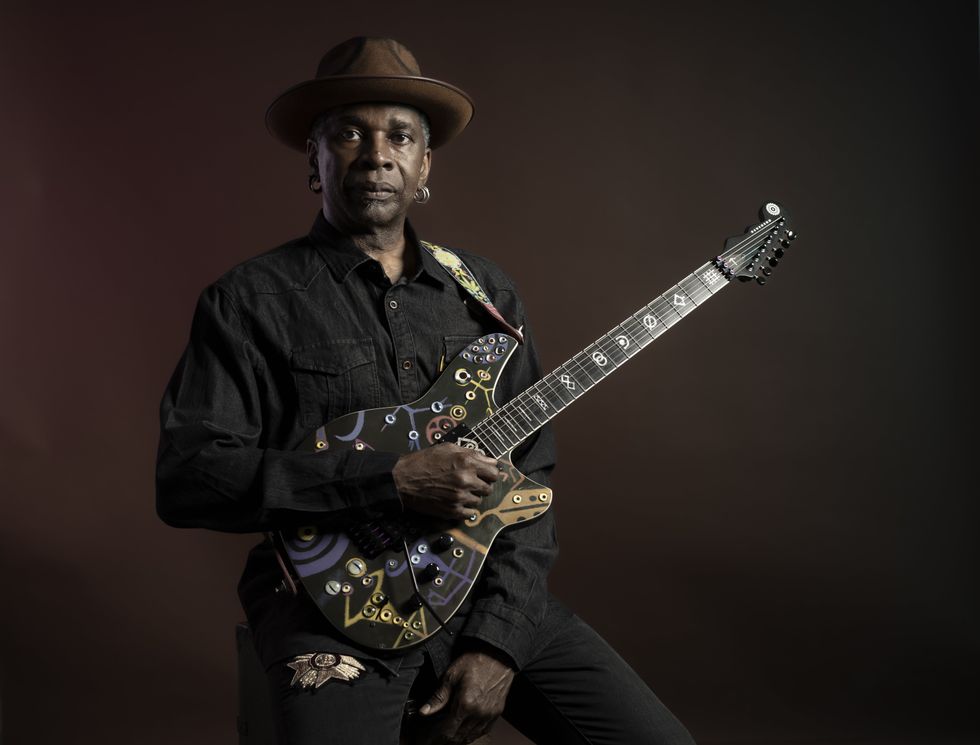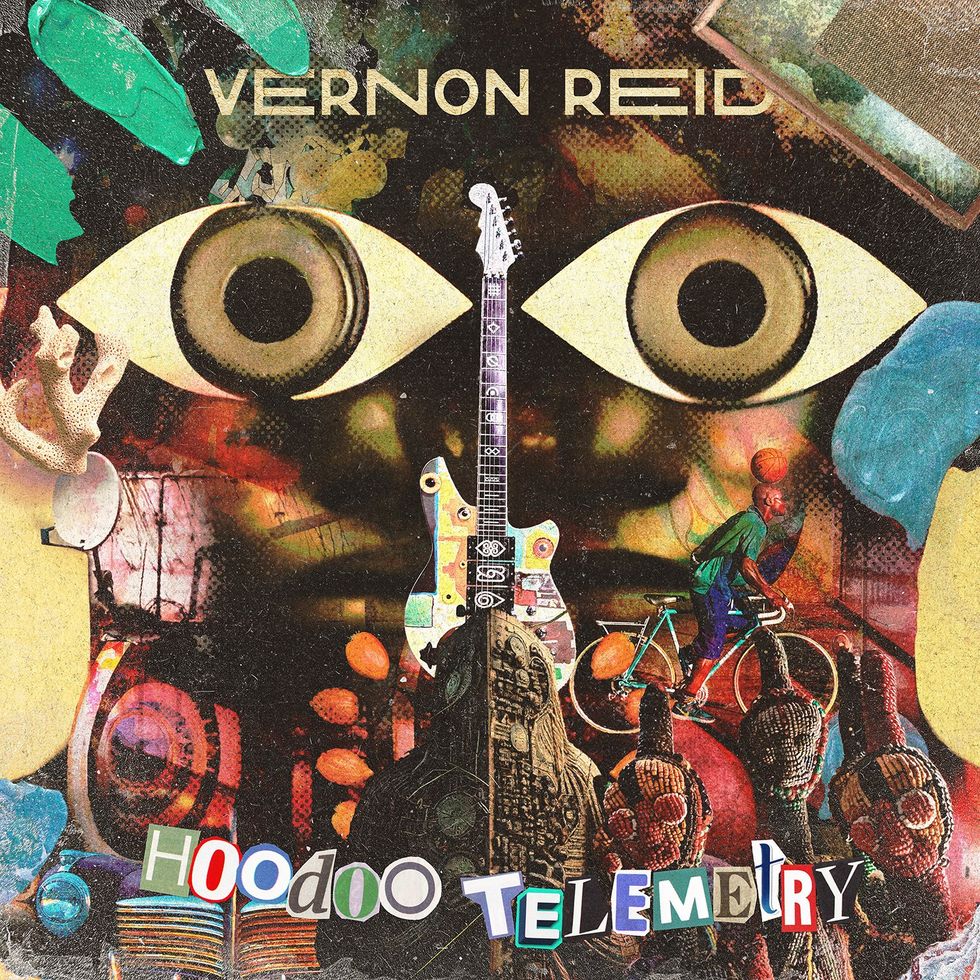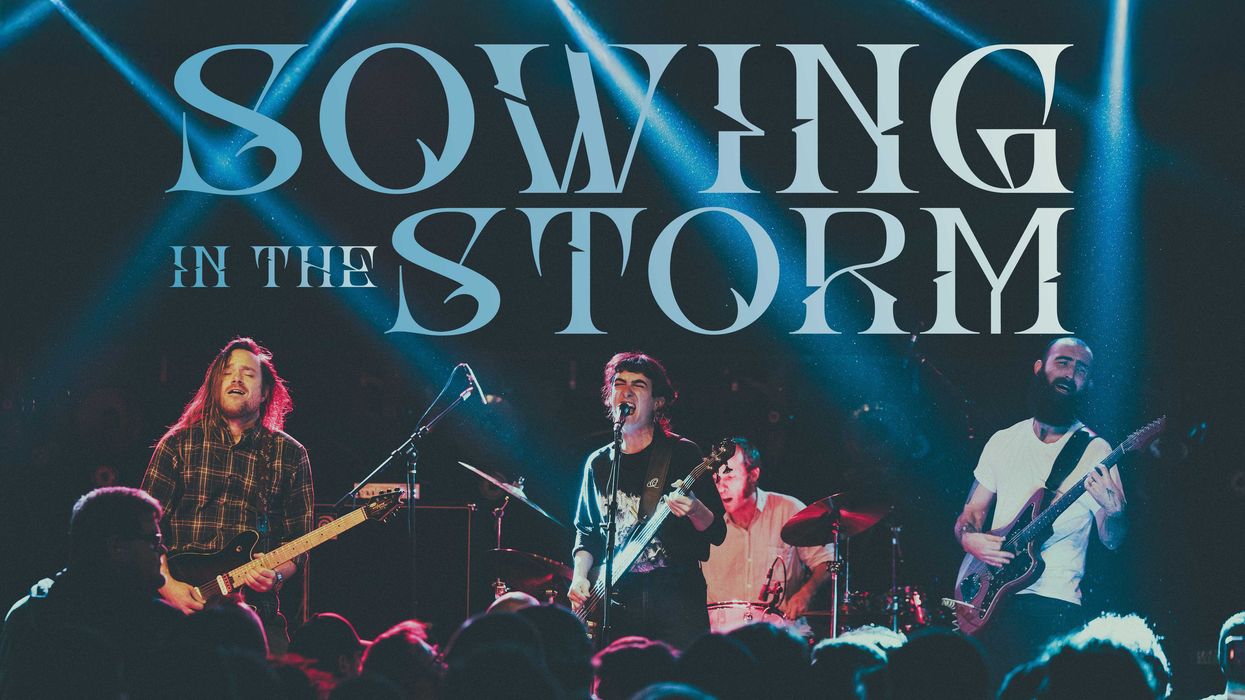Molly Miller, a self-described “high-energy person,” is fully charged by the crack of dawn. When I scheduled our interview, she opted for the very first slot available—8:30 a.m.—just before her 10 a.m. tennis match!
Miller has a lot on her plate. In addition to gigs leading the Molly Miller Trio, she also plays guitar in Jason Mraz’s band, and teaches at her alma mater, the University of Southern California (USC), where, after a nine-year stint, she earned her bachelor’s, master’s, and doctorate in music. In 2022, she became a professor of studio guitar at USC. Prior to that, she was the chair of the guitar department at the Los Angeles College of Music.
Molly Miller's Gear

Miller plays a fair bit of jazz, but considers herself simply a guitarist first: “Why do I love the guitar? Because I discovered Jimi Hendrix.”
Photo by Anna Azarov
Guitars
- 1978 Gibson ES-335
- Fender 1952 Telecaster reissue with a different neck and a bad relic job (purchased from Craigslist)
- Gibson Les Paul goldtop with P-90s
Amps
- Benson Nathan Junior
- Benson Monarch
- Fender Princeton Reverb Reissue (modified to “widen sound”)
Effects
- Chase Bliss Audio Dark World
- Chase Bliss Audio Warped Vinyl
- EarthQuaker Devices Dispatch Master
- EarthQuaker Devices Dunes
- EarthQuaker Devices Special Cranker
- JAM Pedals Wahcko
- JAM Pedals Ripply Fall
- Strymon Flint
- Fulltone Clyde Wah
- Line 6 Helix (for touring)
Strings & Picks
- Ernie Ball .011s for ES-335 and Les Paul
- Ernie Ball .0105s for Telecaster
- Fender Celluloid Confetti 351 Heavy Picks
To get things done, Miller has had to rely on a laser-focused approach to time management. “I’ve always kind of been juggling different aspects of my career. I was in grad school, getting a doctorate, TA-ing full time—so, teaching probably 20 hours a week, and then also doing probably four or five gigs a week, and getting a degree,” explains Miller. “I had to figure out how to create habits of, ‘I really want to play a lot of guitar, and gig a lot, but I also need to finish my degree and make extra money teaching, and I also want to practice.’ There’s a certain level of organization and thinking ahead that I always feel like I have to be doing.”
“The concept of the Molly Miller Trio—and also a part of my playing—is we are playing songs, we are bringing back the instrumental, we are thinking about the arrangement.”
The Molly Miller Trio’s latest release, The Battle of Hotspur, had its origins during the pandemic. Miller and bassist Jennifer Condos started writing the songs in March 2020, sending files back and forth to each other. They finally finished writing the album’s last song, “Head Out,” in December 2021, and four months later, recorded the album in just two days. The 12-song collection is subtle and cool, meandering like a warm, sparkling country river through a backwoods county. The arrangements feel spacious and distinctly Western—Miller’s guitar lines are clean and clear and dripped with just the right level of reverb, trem, and chorus, while Jay Bellerose’s brush-led percussion trots alongside like a trusty steed.
The Battle of Hotspur has a live feel, and that aspect was 100-percent deliberate. Miller says, “That’s the exact intention of our records—we want to create a record that we can play live. Jason Wormer, the recording and mixing engineer that did our record, came to a show of ours and was like, ‘This is incredible.’ He’s recorded so many records and was like, ‘This is the first time I’ve ever recorded a record that sounds the same live.’ And that was our exact intention. Because I feel like [the goal of] the trio itself was to be full. It’s not supposed to be like, ‘Oh, let’s put saxophone and let’s put keys and other guitars on it.’ The concept of the record is a full trio like the way Booker T. & the M.G.’s were. It’s not, ‘Wouldn’t it be cool if you added another instrument?’ No, we’re an instrumental trio.”
Musicality is what separates Miller from the rest of the pack. She has prodigious chops but uses them appropriately, when it makes musical sense, and her ability to honor a song’s written melody and bring it to life is one of her strong suits. “That’s a huge part of what we do,” she says. “The concept of the Molly Miller Trio—and also a part of my playing—is we are playing songs, we are bringing back the instrumental, we are thinking about the arrangement. The solo is a vehicle to further the story, to further the song, not just for me to shred. So often, you play a song, and you could be playing the solo over any song. There’s not enough time spent talking about how to play a melody convincingly, and then play a solo that’s connected to the melody.... Whether it’s a pop song, an original, or a standard, how you’re playing it is everything, and not just how you’re shredding over it.”

Miller still gets pigeonholed by expectations in the music industry, including the assumption that she’s a singer-songwriter: “I don’t sing. I’m a fucking guitar player.”
Photo by Anna Azarov
Miller’s strong sense of melody can be traced to her diverse palette of influences. Even though she’s a “jazzer” by definition, she’ll cover pop songs like the Everly Brothers’ “All I Have to Do is Dream” and the Rolling Stones’ “(I Can’t Get No) Satisfaction.” Miller says, “I spent nine years in jazz school. I practice ‘Giant Steps’ still for fun because I think it’s good for my guitar playing. But it was a release to be like, ‘I am not just a jazz guitar player at all!’ Why do I love the guitar? Because I discovered Jimi Hendrix, right? What made me feel things in high school? Bob Dylan, Jimi Hendrix, and No Doubt. It’s like, Grant Green’s not why I play the guitar.
“I play jazz guitar, but I’m a guitar player that loves jazz. What do I put on my playlist? It’s not like I just listen to Wes Montgomery. I go from Wes Montgomery to the Beach Boys to freakin’ Big Thief to Bob Dylan to Dave Brubeck. The musicians I love are people who tell stories and have something to say—Brian Wilson, Cat Stevens.... They’re amazing songwriters.”
“Whether it’s a pop song, an original, or a standard, how you’re playing it is everything, and not just how you’re shredding over it.”
Despite a successful career, Miller continually faces sexism in the industry. “I went to a guitar hang two days ago. It was a big company, and they invited me to come and check out guitars. And I’m playing—I clearly know how to play the instrument—and this photographer there is like, ‘Oh, so are you a singer?’ And I’m just like, ‘No, I don’t sing. Fuck you,’” recalls Miller. “It’s such an internal struggle because of the interactions I have with the world. This kind of gets this thing in me where I feel like I need to prove to people, like, I am a guitar player. And at this point, I know I’m established enough. I play the guitar, and I know how to play it. I’m good, whatever. There still is this ego portion that I’m constantly fighting, and it comes from random people walking up to me and asking about me playing acoustic guitar and my singer-songwriter career or whatever. And I’m like, ‘I don’t sing. I’m a fucking guitar player.’”
YouTube It
Molly Miller gets to both tour with and open up for Jason Mraz’s band. Here’s a taste of Miller leading into Mraz’s set with some adeptly and intuitively performed riffs from a show in July 2022.







![Rig Rundown: AFI [2025]](https://www.premierguitar.com/media-library/youtube.jpg?id=62064741&width=1245&height=700&quality=70&coordinates=0%2C0%2C0%2C0)


![Devon Eisenbarger [Katy Perry] Rig Rundown](https://www.premierguitar.com/media-library/youtube.jpg?id=61774583&width=1245&height=700&quality=70&coordinates=0%2C0%2C0%2C0)










































